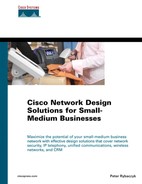Chapter 9. Unified Communications Solutions
The networking and communications industries have coined multiple terms to signify differing levels of unification of the various business communication modes: unified communications solutions, unified communications systems and services, unified messaging, and unified messaging systems and solutions. Two fundamental forces are driving this trend toward unification in business communications. First is the need for high productivity and effectiveness by employees, regardless of their physical location and the communication tools that they have available to them. Second is the proliferation of communication devices.
Although each new device comes with the convenience of its own unique applications, it also comes with the inconvenience of having to remember another number or an interface to service that device. A wide range of computing platforms with Internet and internal e-mail systems, multiple types of phones (mobile, Public Switched Telephone Network [PSTN], IP), personal digital assistants (PDAs), pagers, and fax machines all vie for the attention of SMB employees. They all have their own unique and, more frequently than not, incompatible ways of receiving, sending, and storing information. When managing the multiple (often, too many) means of communication becomes a job in and of itself, it's a clear sign that diversification in communications needs to give way to a greater integration.
In the Cisco Systems vernacular, a unified communications solution is an element of a larger emerging trend of IP communications solutions that encompass IP Telephony, voice applications, IP video conferencing, and customer contact applications. A unified communications solution includes a unified messaging solution (UMS) and combines it with additional personal productivity tools. The Cisco Personal Assistant fills the bill of a personal productivity tool that allows users to determine and manage how and when they want to be reached. The Personal Assistant allows the user to define individual rules for call screening, routing, and forwarding. Calls can be routed based on the time of day, the calendar, or who the caller is. Calls can be forwarded to a single number or a series of numbers. The user has the option of accepting or not accepting a call in real time.
A UMS, on the other hand, integrates messages that originate from multiple sources into a single point of access with a uniform interface. A UMS does not reduce the various modes of business communication (whether real time or highly asynchronous) into one boring and monotonous mode. A UMS aggregates the typical modes of business messaging (voice mail, e-mail, fax) into a single source that is accessible via multiple types of devices in varied business settings (traditional office, while in transit, or a home office).
For example, with currently available UMS tools, a PC can be used to access and listen to voice mail over the Internet, to listen to and view e-mail messages, and to retrieve and forward faxes, in addition to performing all of the typical standard business applications. Likewise, a cellular phone can be used to access voice mail, e-mail, and faxes, although the interface for e-mail access might be abbreviated compared to that on a PC, given the size of display available on a typical cellular phone.
In SMB environments, the synergy that is created through a greater convergence in the means of communication offers a more integrated view of business information, which can readily translate into increased employee productivity and greater customer satisfaction. It is, effectively, a form of business intelligence dividend that results from having the pieces of a jigsaw puzzle (bits and pieces of relevant business information) flowing into one place in front of you, as opposed to having them scattered through multiple media types and inboxes, with varying interfaces and means of retrieval. In short, a business becomes more energy efficient.
However, the deployment of a unified communications solution is not without its pitfalls, for the simple reason that a unified communications solution will create change for just about everyone in the business. It does not matter that, in principle, the change appears beneficial. The risk-reward principle is at work here. The risk is that the larger the number of employees affected by change, the greater the potential for failure. If the changes affecting business communications are introduced in too disruptive a manner, they might be embraced in a lukewarm way, outright rejected, or, in the worst-case scenario, even sabotaged by employees following the implementation.
At the same time, the reward of sweeping changes in business communications can be enormous if those changes are introduced judiciously and are embraced by all affected parties with the aim of advancing the SMB's strategic objectives. Consequently, to minimize the potential for failure, the deployment of unified communications solutions should be subject to a design process that identifies the SMB communications requirements; considers performance, topology, and budget; maintains an ongoing executive sponsorship for the project; and, last but not least, ensures that proper user training follows the solution implementation to take maximum advantage of the available features.
The capabilities of the available unified communications solutions might not be yet at an ideal level that will handle any kind of communication, anytime, and from anywhere, using a single portable appliance; however, the industry is taking appropriate strides in that direction. This chapter focuses on the following:
Deployment considerations for unified messaging solutions
The Cisco Unity solution
The Cisco IP/TV solution
The value of an intranet in an SMB environment
